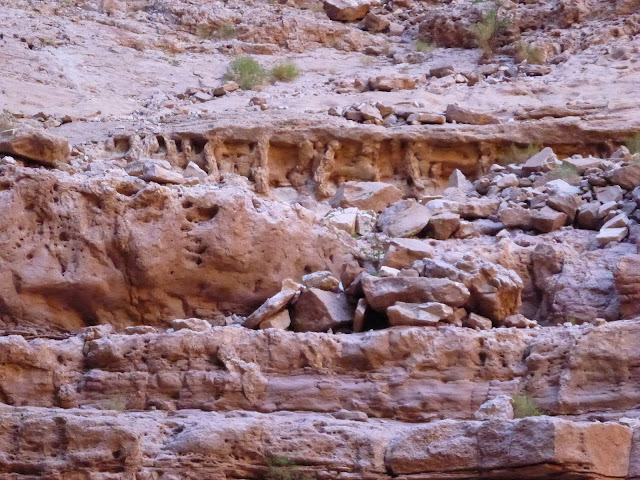Of course, a river trip of such length needs supplies. Here in the hold of our bus is enough liquid refreshment to ward off the hot summer temperatures.
The put-in at Lees Ferry after the four and a half hour drive from Las Vegas. While some folks might consider such a trip something to put behind them, our group relished the idea of driving from the Basin and Range Province to the boundary with the Colorado Plateau, and then climbing onto its red rock heart. Yeah baby!
Our first nights camp was at North Canyon, 20 miles below Lees Ferry. Here is a partial assemble of some of the distinguished geologists on the trip. From left they are Dr. Ron Blakey, co-author with myself of "Ancient Landscapes of the Colorado Plateau," Dr. Ed Spencer, retired geologist and educator at Washington and Lee University in Lexington, VA, Howard Capito, passionate geology fan from Knoxville Tennessee and former student of Dr. Spencer, Wayne Ranney, and Dr. John Warme, retired professor from the Colorado School of Mines. There were other geologists along whom you'll meet further down.
On our first hike up into North Canyon, geologist Gerry Stirewalt observes an outcrop in the Supai Group, specifically a river channel filled with conglomerate. You can see the channel as the concave up feature in the center of the photo.
Beautifully sculpted walls in North Canyon shows evidence for exfoliation in massive (unbedded) sandstone. Since the exfoliated planes are parallel to the shape of the canyon walls, it is likely that the exfoliation formed as rocks were eroded out of the canyon, releasing the load pressure that once confined the rocks.
Our second stop was new to me - a fossil-rich ledge in the Redwall Limestone section of Marble Canyon. Here is a nicely preserved rugose (or horn) coral with branching corals nest to it.
Another well preserved coral at the site, located at river mile 24.5.
John Warme explaining the formation of chert nodules in the Redwall at the same fossil site.
Rapid 24.5 Mile.
The last stop on this second day was to view in detail some of the Devonian-age channels cut into the Muav Limestone. Here is an excellent view of a channel about River Mile 39.
The older Muav Limestone is the light colored rock on the right. It is approximately 125 million years older that the purple layer on the left, called the Temple Butte Limestone. Before Temple Butte deposition, a channel was cut into the Muav and then filled with the purple sediment.
Admiring more channel-forms and some root casts in the Tempe Butte Limestone.
John Warme thinks the vertical burrows shown beneath the topmost visible bed might be lungfish burrows. AN expert in such matters will travel with him to this site on his river trip in September.
Part II follows this in the next post.













No comments:
Post a Comment
If your comment will not post, email me with the problem.